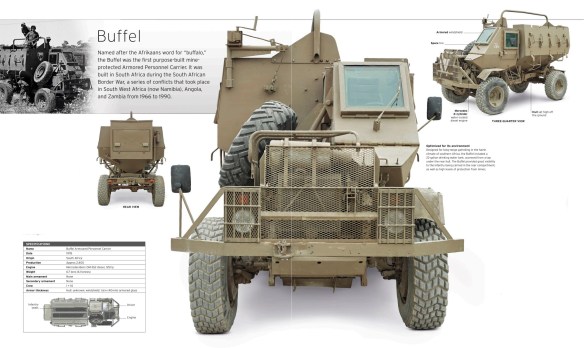Buffel Named after the Afrikaans word for “buffalo,” the Buffel was the first purpose-built mine-protected Armored Personnel Carrier. It was built in South Africa during the South African Border War, a series of conflicts that took place in South West Africa (now Namibia), Angola, and Zambia from 1966 to 1990.
While many vehicles had used V- or boat-shaped hulls to deflect mine blasts away from their undersides-for example, the Saracen APC-the Buffel was the first vehicle to have the survivability of the driver and mounted infantry as the priority in the design brief. Its design led to the Mine-Resistant Ambush Protected concept (MRAP) in the 2000s, which resulted in tens of thousands of vehicles being built for use in Iraq and Afghanistan. The Buffel was a development of the earlier Bosvark vehicle-a Mercedes Benz Unimog truck modified with a basic level of mine protection. The Buffel took the design further using the same Mercedes Benz U416-162 Unimog chassis, but with a driver’s position set high off the ground behind the front axle, and with bulletproof windows to the front and sides. The open-topped rear troop compartment could carry ten infantrymen, each with a four-point seat belt harness, back to back. Entry to the vehicle was over the sides of the compartment, which were hinged to allow the armor to be dropped down
The Buffel APC was the first South African military vehicle to be used in the war of Angola with the characteristics of a “mine-protected vehicle”. It was not the most comfortable vehicle used in this conflict, but it offered all the protection that would be necessary to protect against mine explosions. With a 6 cylinder water-cooled diesel engine on a Unimog Chassis. the Buffel could reach a speed of 96 km per hour on roads. and 30 km per hour off-road. That’s a strong performance for an APC with the capacity to carry a crew of 10 men. The needs of the African army for an open cargo APC for delivery services were immediately realised to transform the Buffel’s open cargo compartment into a troop compartment. Once again, the Buffel proved its ability and versatility to the army. South Africa introduced the Buffel APC into army services in 1978. 1,400 Buffels were produced and delivered until production ended. Taking advantage of the vehicles that survived the war in Angola, the last Buffels where deployed to Sri Lanka and Uganda.
Variants
Buffel – original
Buffel Mk 1 – Improved engine and bushguard/bumper
Buffel Mk 1B – Disc brakes replaced drum brakes
Log Buffel – Logistic/Cargo version, a standard Buffel with the seat assembly removed from the troop compartment
Moffel – See Buffel Mk IIA below.
Unicorn – Sri Lankan produced version of the Buffel original.
Unibuffel – Sri Lankan produced version of the Mk 1 with a Tata engine and an enclosed troop compartment.
Buffel Mk IIA – Essentially a rebuild of earlier Mk 1s with an enclosed troop compartment, a rear exit door and large bulletproof windows on the sides and rear. Referred to as Moffel.
Buffel Mk IIB – Cargo carrier. The SA Army ordered 57 of these in the early 1980s. Payload capacity stated as 2.637 tons.
Bulldog – based on SAMIL 20 truck with the driver’s cab on the right. The Bulldog was utilized by the SAAF for patrolling airfields. A variant called the Ystervark was produced and used in the anti-aircraft role.[1]
Rhino – A further development of the Bulldog but with the driver seated inside a fully enclosed troop compartment. 20 were produced for the SAAF.
